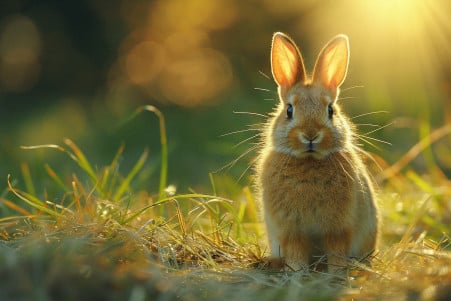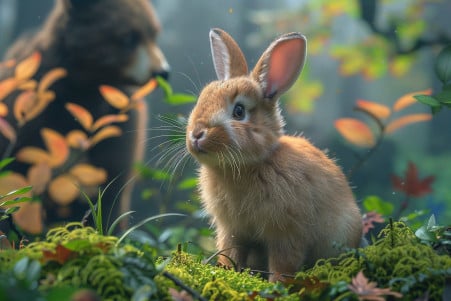What Do Snakes Eat? An In-Depth Look at Predator-Prey Relationships
27 April 2024 • Updated 27 April 2024

Knowing whether or not snakes eat rabbits can tell you a lot about a snake's behavior and the danger it might pose to other animals. After all, snakes are carnivorous reptiles that eat a variety of animals, including small mammals, birds, amphibians, and other reptiles, like rabbits. While the snake's size and species will determine what it eats, many snakes, including rat snakes, corn snakes, and king snakes, are rabbit predators.
In this article, we'll explore scholarly articles from the fields of herpetology, zoology, and ecology to learn more about the snakes that eat rabbits and their relationship with rabbit populations. Not only will this help us better understand these reptilian predators, but it will also help us better understand the delicate balance of local ecosystems, which can in turn help with conservation and the responsible management of the environment.
Do snakes eat rabbits?
Snakes That Eat Rabbits and Their Hunting Techniques
Some of the larger species of snakes, including Burmese pythons, reticulated pythons, boa constrictors, bullsnakes, and anacondas, are known to hunt rabbits. These large constrictors use constriction as their primary method of hunting, which involves wrapping their bodies around their prey and squeezing them until they are dead or immobilized. The Burmese and reticulated pythons, two of the largest snakes in the world, can take down prey as large as deer and have even been known to kill full-grown humans, so rabbits are easy prey for them.
Snakes have a number of physical adaptations that allow them to eat prey that is much larger than the size of their head. Their jaws are connected by ligaments that are stretchy, which means they can unhinge and stretch to accommodate large prey. Their skin and muscles are also very elastic, so they can stretch to fit large prey like rabbits.
The process of eating a rabbit is slow and methodical, involving striking and constricting the prey, unhinging the jaws to fit the prey into the mouth, using teeth that point inward to move the prey down the throat, and using the muscles in the body to move the prey through the body and out as waste over the course of days or even weeks.
How Often Do Snakes Eat Rabbits and What Influences Their Prey Choices?
Snakes use a combination of active hunting and ambush hunting, and they use chemical and visual cues to find the best place to ambush and then strike their prey. One study on the hunting and feeding behavior of rattlesnakes even showed that snakes will sometimes change their environment to make it more likely that they'll be able to successfully strike at whatever comes into their range.
The likelihood of a snake's hunt being successful depends on a number of factors, including the strength of the snake's venom (if it's a venomous snake), the prey's ability to resist, and the snake's ability to track and catch the prey if it gets away. Snake Predation Strategies explains that venomous ambush predators and constrictors have evolved to have different specializations that help them subdue their prey.
Some of the most important factors that determine whether snakes will hunt and eat rabbits include the amount of habitat that snakes and rabbits share, the number of rabbits in a given area, the species and size of the snake, and the availability of other prey. One study on the impact of Burmese pythons in the Everglades showed that 77% of marsh rabbit deaths were caused by python predation, and that the number of deaths increased as the temperature increased.
Snakes can have a big impact on rabbit populations by preying on them, changing their behavior, and affecting their population dynamics, but the extent of the impact depends on the species and the environment. For example, the Burmese python has been shown to cause a dramatic decline in the population of marsh rabbits in Everglades National Park.
How to Keep Rabbits Safe From Snakes
If you keep pet rabbits in outdoor hutches or enclosures, you may need to take steps to protect them from snakes, especially if you live in an area where snakes are common. VetVoice explains that to prevent snakes from getting into rabbit hutches, owners need to find and seal all openings that are larger than 1 cm, since some snakes can fit through even small gaps.
When it comes to walking dogs, the Halifax Humane Society says that dogs should be kept on a short leash to prevent them from getting too close to snakes and that they should be discouraged from chasing or investigating snakes, which can lead to dangerous situations. If a pet is bitten by a venomous snake, the RSPCA recommends seeking immediate veterinary care, since the sooner a pet receives treatment, the better their chances of survival. It's also important to let the vet know as much as possible about the snake that bit the pet, since pets that are bitten by venomous snakes may need antivenom and other treatments to save their lives.
Recognizing the dangers snakes can pose to pet rabbits and taking steps to protect them from these dangers is an important part of being a responsible pet owner. However, the impact of snakes on wild rabbits can be even more serious, which we'll cover next.
How Snakes Affect Wild Rabbit Populations
Snakes can affect wild rabbit populations in several ways, including predation, changes in rabbit behavior, and impacts on population dynamics. For example, a study of the effects of Burmese pythons in the Everglades found that python predation was responsible for 77% of marsh rabbit deaths, and that predation increased with temperature. This unsustainable level of predation has led to a dramatic decrease in the native rabbit population, which is a threat to the local ecosystem.
The extent of these effects depends on a number of factors, including the species of snake, the degree of habitat overlap, and the availability of other prey. For example, a study of rabbit biology found that the factors that determine whether a snake will hunt and eat rabbits include the proximity of rabbit populations, the size and hunting ability of the snake, and the availability of other prey.
Ensuring that there is enough food and high-quality habitat for rabbits is important for ensuring that rabbit populations remain healthy and that the impacts of snake predation are minimized. The study emphasizes the complexity of snake-rabbit interactions, which can be used to guide conservation efforts and encourage responsible land management. This complexity also highlights the importance of understanding predator-prey relationships in order to conserve vulnerable rabbit populations and maintain the balance of local ecosystems.
Evolutionary Adaptations of Snakes and Rabbit Prey
Snakes have evolved a number of morphological traits that help them effectively hunt and capture rabbit prey. These include the vomeronasal organ that helps them detect the scent of prey, slender bodies that can move quickly and easily into burrows, and heat-sensing pits.
While ambush predators and active hunters have different body shapes that are adapted to their hunting strategies, both use similar tactics to subdue their prey, such as venom and constriction. One study notes that rabbits, as one of the most important prey species, have evolved traits like a high intake capacity, flexible digestive physiology, and caecotrophy to make sure they can use nutrients efficiently and maintain their populations.
The predator-prey arms race has led to the evolution of the adaptations and survival strategies of both snakes and rabbits. This is important to keep in mind when it comes to conservation and the protection of species.
Conclusion: What This Means for the Complex Predator-Prey Dynamics
Snakes are important predators in many ecosystems, and rabbits are a common prey species. However, whether or not snakes will hunt and eat rabbits depends on a number of factors, including the species of snake, its size, the amount of overlap in its habitat with rabbits, and the availability of other prey. At the same time, while some snakes can have a big impact on rabbit populations through predation, rabbits have evolved a number of traits that help ensure their survival and growth.
Therefore, responsible conservation and management should take into account the complex predator-prey dynamics between snakes and rabbits, as well as the broader ecological impacts. This knowledge can help ensure that conservation and management efforts are more successful in maintaining healthy ecosystems and the biodiversity they support.


